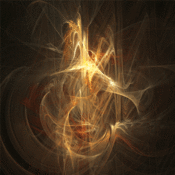
Geeky science philosophizing - on Decoherence - from Stuart Kauffman at NPR's 13.7: Cosmos and Culture blog.
November 29, 2010
The current best accepted approach to the emergence of the classical world from the quantum world requires a fundamental shift from considering closed quantum systems that cannot lose phase information to open quantum systems in a quantum environment that can lose phase information to the environment.
This loss of phase information is known as DECOHERENCE.
To gain an intuitive understanding of decoherence, return to the water waves passing through the two gaps in the sea wall and propagating toward the beach. Imagine that a “decoherence” process was able to “lose” information about where the peaks and troughs of the propagating waves were to regions outside the local system. As this occurred, the “decoherent” waves, upon hitting the beach, would not “know” where peaks and peaks summed to higher peaks and peaks and troughs cancelled.
In a mathematically similar way, the phase information in the Schrodinger wave equation for an open quantum system can be lost into the environment. As this phase information is lost from the open quantum system to the environment, the capacity of the open quantum system to exhibit constructive and destructive interference can decay, so the capacity to exhibit this hallmark of quantum behavior decays. A. Leggett has studied decohrence extensively and shows that the classical world can be approached ever more closely and classicity can be “achieved for all practical purposes, FAPP.”
Decoherence is well established experimentally and hinders quantum computation.
I will now describe some of what is or appears to be known about decoherence.
Decoherence takes an interval of time. A femtosecond, 10 to the - 15 seconds, is a typical time scale.
Decoherence is a dissipative process, phase information is LOST from the open quantum system to the environment, thus during decohrence, the Schrodinger equation cannot propagate unitarily.
Since decoherences takes an interval of time, where a femotsecond is very long on the Planck time scale of 10 to the - 43 seconds, and the unitary Schrodinger equation does not hold, we can expect new physics in the open quantum system in its environment.
One example of such new physics is seen in the Quantum Anti Zeno Effect, established experimentally with supercooled sodium ions. The essential result is that decay from one to another quantum state is here FASTER THAN EXPONENTIAL. Recall that familiar radioactive decay is a Markovian process and also a Poisson process, giving rise to the familiar exponential decay of a set of radioactive nuclei and the familiar half life of radioactive decay. The critical result of the Quantum AntiZeno Effect is that the behavior is no longer Markovian or Poisson. It is new physics.
Seth Lloyd, a quantum physicist from MIT, informs me that during decoherence superpositions of solutions of the Schrodinger equation DECOHERE VERY RAPIDLY, LEAVING PURE STATES PROPAGATING. This loss of propagating superpositions of the Schrodinger equation in a closed quantum system is new physics. Schrodinger’s cat is no longer a superposition of both dead and alive. Other physicists agree with Lloyd. What is left propagating are “pure states”, not superpositions. This is new physics compared to closed quantum systems where superpositions propagate too.
Decoherence can have effects on chemical reactions, speeding or slowing them. This too is new physics.
The study of decoherence in chemistry is just beginning with early work on coherent electron transfer in proteins in the presence of decoherence.
Decoherence broadens absorption and emission bands in the spectra of chemicals.
Decoherence may well alter the behavior of molecules, for example, if some or all heavy nuclei decohere FAPP, altering rotational and vibrational bond behaviors.
While decoherence is well established, there are also several lines of evidence that open quantum systems that are partially decoherent or classical FAPP can partially or fully RECOHERE, in the limit to fully coherent quantum behavior.
If recoherence can occur, passage from quantum to classical FAPP is reversible!
Several theoretical papers by Paz and colleagues and Briegel show how a quantum entangled system can decohere to classicity and, in “Sudden Death and Revival”, return to fully quantum coherent behavior. This has now been demonstrated experimentally, Science News, November 20, 2010.
In a fundamental theorem by Shor (84) concerning quantum computer error correction, Shor shows that it is possible to measure some entangled quibits, detect that some qubits are decohering, INJECT INFORMATION into the now OPEN quantum system, and correct the decohering qubits to fill coherece. This theorem has spawned efforts at devising quantum error correction processes.
The behavior of chlorophyll wrapped by its antenna protein MAY be the first experimental indication of recoherence.
The expected time scale of decoherence for chlorophyll is on the order of a femtosecond. When measured about a year ago, the stunning results for this system at 77K was that chlorophyll remained coherent for at least 7000 femtoseconds. This is creating a large new effort in quantum biology.
Similar effects have been found with other light harvesting biological molecules wrapped by their analogues of the antenna protein. Mutations to the proteins tend to destroy the long lived coherence, suggesting strongly that natural selection has acted on the antenna proteins.
Now we confront two possibilities. Either the antenna protein, laden with chromophores which absorb and emit photons, PREVENTS DECOHERENCE of chlorophyll, or THE ANTENNA PROTEIN PROMOTES RECOHERENCE. My own guess is the latter, for it is hard to imagine how the antenna protein could entirely prevent decoherence of chlorophyll.
One wants to guess that the photons emitted and absorbed by the chromophores are injecting information, Shor Theorem-like, into the chlorophyll molecule and inducing recoherence. Perhaps this is achieved by the light emitted by the chromophores and absorbed by the chlorophyll molecule being in the center of the broadened absorption and emission bands of chlorophyll. Clearly this is open to experimental test.
I broach in the next blog post the Poised Realm which may mediate between Res Potentia and Res Extensia.
No comments:
Post a Comment